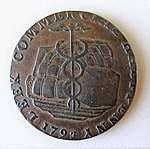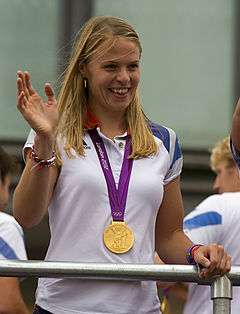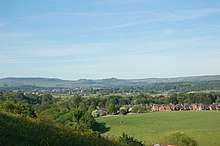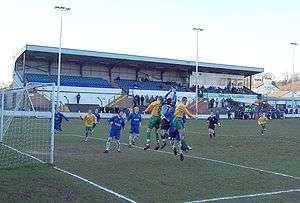Leek, Staffordshire
Leek is a market town and civil parish in the county of Staffordshire, England, on the River Churnet. It is situated about 10 miles (16 km) north east of Stoke-on-Trent. It is an ancient borough and was granted its royal charter in 1214.
| Leek | |
|---|---|
Leek town centre | |
 Leek Location within Staffordshire | |
| Population | 20,768 (2011 Census)[1] |
| OS grid reference | SJ984565 |
| Civil parish |
|
| District | |
| Shire county | |
| Region | |
| Country | England |
| Sovereign state | United Kingdom |
| Post town | LEEK |
| Postcode district | ST13 |
| Dialling code | 01538 |
| Police | Staffordshire |
| Fire | Staffordshire |
| Ambulance | West Midlands |
| UK Parliament | |
It is the administrative centre for the Staffordshire Moorlands District Council. King John granted Ranulph de Blondeville, 6th Earl of Chester, the right to hold a weekly Wednesday market and an annual seven-day fair in Leek in 1207.
Leek's coat of arms is made up of a Saltire Shield. On the top is the Stafford Knot, either side is the Leek "Double Sunset" and below a gold garb. The crest is a mural crown with three Mulberry leaves on a Mount of Heather on top of which a Moorcock is resting his claw on a small-weave Shuttle. The motto 'ARTE FAVENTE NIL DESPERANDUM' translates to: Our skill assisting us, we have no cause for despair.
Economy

The town had a regular cattle market for hundreds of years,[2] reflecting its role as a centre of local farming. Following the Industrial Revolution it was a major producer of textiles, with silk working in particular coming to dominate the industrial landscape.[2] However, this industry has now ceased.
The mills from the town's textile era remain and many have now been converted into housing.[3]
Britannia, the former Building Society, has its headquarters in the town and was a large local employer.
Geography
.jpg)
Most of the town is at or above 600 feet (180 m) and is surrounded by the higher countryside of the Staffordshire Moorlands which is situated on the southern uplands of the Pennines.
Leek is built on the slope and crown of a hill which is situated just a few miles south of the Roaches; a gritstone escarpment which rises steeply to 1,657 feet (505 m).
Leek is situated at the foot of the Peak District National Park and is therefore often referred to as the Gateway to the Peak District, although the town is more often referred to as the Queen of the Moorlands.
Architecture and development
Listed buildings include the original parish church, St Edward the Confessor's, and a Victorian church, All Saints', designed by Richard Norman Shaw. Many Victorian period buildings still stand in the town.
Sugden buildings
Many of Leek's buildings were built by the family architectural practice of the Sugdens. In 1849 William Sugden (b. 1821 in Keighley) came to Leek. He was an architect and his work on the design of the railway stations for the Churnet Valley Railway brought him to the area. In the following year William’s son, Larner Sugden, was born. After schooling in Yorkshire, Larner returned to Leek in 1866 to be apprenticed to his father as an architect, and thus was formed the famous Sugden & Son (Architects), whose influence on the town was to be profound. The firm had offices in Derby Street. The building still survives, the ground floor now being occupied by Boots the Chemist. Larner was a great supporter of the Society for the Protection of Ancient Buildings, and so Leek’s development was in sympathetic hands.
The architectural output from Sugden & Son was both prolific and varied. Some of the buildings designed by the Sugdens are as follows:
- the Congregational Church with its 130’ spire, (now Trinity Church), built in the Victorian Gothic Revival style (1863)
- Myatt’s Mill in Earl Street (1864)
- Mill Street Methodist Chapel and Ragged School (1870),
- the Cottage Hospital, in memory of silk manufacturer James Allsop (1871),
- their own houses in Queen Street, complete with monograms for William, Larner and for Larner’s French wife (1877),
- West Street School (extended in 1881),
- the District Bank, which exhibits a strong Richard Norman Shaw influence (1882)
- the Leonard Street Police Station in Scottish Baronial style (1891). This last was probably the last joint venture of the father-and-son team because William Sugden died in 1892.
The Sugden masterpiece was, perhaps, the Nicholson Institute, built in the Queen Anne style, in 1882. The fact that this building is tucked away behind the 17th century ‘Greystones’ is a further indication of Larner’s regard for old buildings. Larner would not countenance demolition of the old building, and so, as the Nicholsons owned the land to the rear, that is where the Institute was built. Larner cleverly incorporated the busts of Shakespeare, Newton, Reynolds and Tennyson into the building representing 400 years of artistic and scientific achievement from the 16th to the 19th century and embracing literature, science, art and poetry.
In 1899 came the Technical Schools and the Co-operative Society Hall. Although the original town centre cattle market was demolished and replaced with a bus station and shopping centre in the 1960s, the new cattle market was built on the edge of town adjacent to the railway station. Later, this was one of the stations closed following Dr. Beeching's recommendations, and a supermarket (Morrisons) now stands on the site.
The Nicholson War Memorial was dedicated in 1925.[4]
Leek offers some contemporary architecture, most notably the alterations and refurbishment to Trinity Church on Derby Street (2011) and new teaching building on Horton Street for Leek College (2013).
Notable residents
Leek was the home of James Brindley,[5] the 18th century canal engineer. He built a water-powered corn mill in 1752. This watermill is now preserved as Brindley Water Mill and Museum.[6]
William Morris,[7] founder of the Arts and Crafts movement, often visited Leek between 1875 and 1878. He studied dyeing with Thomas Wardle,[8] owner of a dyeworks in the town, and it was Leek which provided his firm with silk. It was through the Society for the Protection of Ancient Buildings, which he founded in 1877, that he came into contact with Larner Sugden, the local architect, who went on to publish some of Morris' speeches and essays in a series called the Bijour of Leek.
Dame Averil Cameron[9] Professor of Late Antique and Byzantine History in the University of Oxford and former Warden of Keble College grew up in Leek.

Dave Hill,[10] vocalist for English new wave of British heavy metal band Demon, lives in Leek and currently operates rides at Alton Towers. James Ford,[11] English musical composer, record producer and musician in the band Simian Mobile Disco was born in Stoke-on-Trent and grew up in Leek "playing bass and singing in bands by the age of ten."[12] Also, He is currently the producer of the Arctic Monkeys and Depeche Mode.
Amongst sports people associated with the town, the best known person is former five-time world professional darts champion Eric Bristow[13] who used to live in the town. Dr. Anna Watkins,[14] born in Leek, won a gold medal for rowing in the 2012 Olympics. Footballer Arthur Hulme (1877–1916)[15] was born in Leek. Former England test cricketer Kim Barnett[16] was born and lives in Leek.
- and
- Thomas Parker, 1st Earl of Macclesfield, PC, FRS (1666 in Leek – 1732) Whig politician,[17] Lord Chief Justice 1710 to 1718, impeached for corruption 1725, fined and placed in the Tower of London
- William Benton Clulow (1802 in Leek – 1882) dissenting minister,[18] tutor and writer.
- Thomas Bullock (1816 in Leek – 1885) Mormon pioneer,[19] emigrated to Nauvoo, Illinois in 1843
- Alice Tredwell (1823 in Leek – 1867) railway contractor[20] and photographer, particularly in India
- William Bromfield (1868–1950) trade unionist and Labour Party politician,[21] MP for Leek 1918 / 1931 and 1935 / 1945
- John Platt (1886 in Leek – 1967) painter,[22] woodcut artist and head of Leek School of Art 1910 / 1919
- Sir Philip Brocklehurst (1887 in Swythamley Park – 1975)[23] Nimrod Expedition in Antarctica 1907–1909, led by Ernest Shackleton
- Geoffrey Wedgwood, ARCA, RE (1900 in Leek – 1977) etcher and engraver,[24] best known for his architectural etchings
- Cyril Plant, Baron Plant CBE (1910 in Leek – 1986) trade unionist, general secretary of the Inland Revenue Staff Federation
- Donald Nicholson (1916 in Leek – 2012) scientist,[25] devised charts of Biochemical cycles and Methodist lay preacher
- William Bowyer RA (1926 in Leek - 2015) portrait and landscape painter,[26] his work is "modern traditional" figurative painting
- Basil Hayward (1928 in Leek – 1989) footballer and manager,[27] played in 349 league games for Port Vale F.C., 1946 to 1957
- Ken Coates (1930 in Leek – 2010) Labour Party[28] Member of the European Parliament, 1989 to 1999
- Roy Fowler (1934 in Leek – 2009) long-distance runner,[29] nicknamed "Red Fox" due to his speed and his red hair
- Stuart Sharratt (born 1942 in Leek) former football goalkeeper, 152 appearances for Port Vale F.C.
- Tony Lacey (born 1944 in Leek) former footballer,[30] made 201 appearances for Port Vale F.C.
- Tom Levitt (born 1954) brought up in Leek, Labour Party politician,[31] MP for High Peak 1997 to 2010
- Wayne Corden (born 1975 in Leek) former midfield footballer,[32] made 471 pro appearances
Tourist attractions and leisure

Nearby Rudyard Lake is a popular tourist attraction and home to the Rudyard Lake Steam Railway, running along its eastern shores. Other nearby local attractions are the local football club Leek Town F.C., Alton Towers, the cultural and leisure facilities of the city of Stoke-on-Trent, and the Peak District National Park. The Churnet Valley Railway at Cheddleton also attracts several thousand passengers a year, and they are currently working in partnership with Moorlands & City Railways to extend the CVR the 1 mile from its current northern terminus at Leekbrook back into Leek itself along the former North Staffordshire Line.[33] Longer term plans include the development of a North Staffordshire museum alongside the new railway station, and a new canal marina.
Leek's "Double Sunset" on and around the summer solstice also attracts many tourists. This event, first recorded by Robert Plot, occurs when the sun sets behind the Cloud, subsequently partially reappearing in the hollow of the hill's steep northern side, before setting again. Plot's detailed account can be found in his book The Natural History of Staffordshire. Traditionally, the best location for seeing the double sunset was in the grounds of the parish church, but it is no longer visible from there. Currently, the best locations to witness the spectacle are from Lowe Hill, on the outskirts of the town, and from the private road to Pickwood Hall, off Milltown Way. The phenomenon and its possible observation points are described in detail in Jeff Kent's book, The Mysterious Double Sunset.[34]
Every year in May, Leek Arts Festival takes place, celebrating the cultural heritage of the town. According to the festival's website, it began as a weekly event but soon expanded to last a whole month.
The surrounding countryside of the Staffordshire Moorlands and the Peak District makes the area a popular tourist destination. The town is on a key route north to Buxton via the A53 road. Just outside the town is Peak Wildlife Park, which is renowned for its large collection of birds. Also nearby is Coombes Valley RSPB reserve, an RSPB reserve since 1963, with walks and trails through a wooded valley.[35] Deep Hayes Country Park, created around a former reservoir, is a short distance south-west on the A53 road.
Leek came second in the Telegraph's "High Street of the Year 2013", behind winner Deal in Kent.[36]
Local transport
The town of Leek is served by First with a regular number 18 bus service (or 16 on an alternative route via Cellarhead). There are also bus services to the nearby towns of Buxton and Macclesfield.
Leek was served by Leek railway station, which was opened by the North Staffordshire Railway on 13 July 1849 but was finally closed in 1965. (The Stoke-Leek line lost its passenger service in 1956, whilst the Northern section of the Churnet Valley Line to Macclesfield was closed in 1960 before the Southern section to Uttoxeter closed in 1965). Leek railway station was completely demolished in 1973.
Plans are afoot to build a new station roughly half a mile south of the original, as part of bigger plans to develop the Barnfield area of Leek as a tourist attraction.[37] The re-introduction of a railway service is being directed under the "Reconnect Leek" banner,[33] and forms part of proposals to reopen the Stoke - Leek line which survived as a goods only line to serve the former sand quarry at Oakamoor.
Sport

The town's first known football club was Leek F.C. It was formed in the late 1870s, and wound up in the 1890s.[38][39]
Leek has four football clubs. Leek Town F.C., founded in 1946, are based at Harrison Park and currently play in the Northern Premier League Division One South. They were founder members of the North West Counties Football League in 1982 and in 1997 they were Northern Premier League champions and gained promotion to the Football Conference. Leek CSOB, founded in 1945, groundshare with Leek Town at Harrison Park and play in the North West Counties Football League Division One. They were founder members of the Staffordshire County League in 1984, and were league champions in 1996. Ball Haye Green FC founded in 1880 play in the Staffordshire County Senior League and most recently won the Staffordshire FA Vase in 2017.[40] In 2016, Staffordshire Moorlands FC were set up in the town and began their first season in the league pyramid.[41]
Leek Hockey Club is based on Macclesfield Road at the edge of the town where they have a club house and four grass pitches, although all League matches are played on their own astroturf pitch at Leek High School as well as using synthetic pitches at Westwood College. Previous players have included Olympic gold medallist Imran Sherwani and England and GB international Scott Cordon.
Leek Archery Club use the Macclesfield Road site for outdoor shooting, but have shot indoor at Biddulph High School since 2011.[42]
Leek & District Gun Club host monthly Clay Pigeon shoots at Westwood Farm, west of Leek.[43]
Leek Rugby Union FC bears the name of the town but is based in nearby Cheddleton.
Schools
- All Saints' Church of England First School[45]
- Churnet View Middle School
- St Edwards Middle School
- Leek High School
- Westwood College
- Leek School of Art, part of Buxton & Leek College
Notes and references
| Wikimedia Commons has media related to Leek, Staffordshire. |
| Wikivoyage has a travel guide for Leek. |
- "Town population 2011". Retrieved 3 December 2015.
- . Retrieval Date: 29 July 2010.
- Burnett, Tom (5 April 2019). "Regeneration of the mills - what does the future hold for town's past?". stokesentinel. Retrieved 29 April 2020.
- "The Memorial". Nicholson War Memorial. Archived from the original on 14 March 2012. Retrieved 9 February 2012.
- . Encyclopædia Britannica. 04 (11th ed.). 1911.
- Brindley Mill. Retrieval Date: 22 August 2007.
- . Encyclopædia Britannica. 18 (11th ed.). 1911.
- . Dictionary of National Biography (2nd supplement). London: Smith, Elder & Co. 1912.
- Averil Cameron (28 October 1994). "Past Masters". The Times. Retrieved 18 December 2010.
- Demon discography at Discogs retrieved 6 March 2018
- James Ford, Allmusic retrieved 6 March 2018
- Mixmag Interview 14 May 2012 Archived 28 December 2013 at the Wayback Machine Interview for Mixmag. Retrieval date: 28 December 2013.
- Eric Bristow's profile and stats on Darts Database retrieved 6 March 2018
- British Rowing, Profile retrieved 6 March 2018
- Playing record: Arthur Hulme, Swindon-Town-FC.co.uk retrieved 6 March 2018
- ESPN cricinfo Database retrieved 6 March 2018
- AIM25 project, Parker Manuscript retrieved 6 March 2018
- Stephen, Leslie, ed. (1887). . Dictionary of National Biography. 11. London: Smith, Elder & Co.
- Thomas Bullock, Find a Grave retrieved 6 March 2018
- Alice Tredwell's Photographs, VADS retrieved 6 March 2018
- HANSARD 1803–2005 → People (B), Mr William Bromfield retrieved 6 March 2018
- Art UK site, 18 Painting(s) by or after John Platt retrieved 6 March 2018
- Staffordshire:The Great War, Brocklehurst Brothers retrieved 6 March 2018
- Visualarts, britishcouncil.org, Geoffrey Heath Wedgwood retrieved 6 March 2018
- The Guardian, 29 May 2012, Obituary retrieved 6 March 2018
- The Guardian, 19 Mar 2015, William Bowyer, Obituary retrieved 3 March 2018
- SoccerBase Database retrieved 6 March 2018
- The Guardian, 29 Jun 2010, Obituary retrieved 6 March 2018
- IMDb Database retrieved 6 March 2018
- Stats at Neil Brown stat site retrieved 6 March 2018
- TheyWorkForYou, Tom Levitt, former MP, High Peak retrieved 6 March 2018
- SoccerBase Database retrieved 6 March 2018
- "Archived copy". Archived from the original on 12 August 2014. Retrieved 6 August 2014.CS1 maint: archived copy as title (link)
- The Mysterious Double Sunset, by Jeff Kent, ISBN 0-9529152-5-1.
- "Coombes Valley". Retrieved 28 December 2017.
- https://www.telegraph.co.uk/lifestyle/reinvent-the-high-street/10547216/Reinventing-the-high-street-Deal-wins-high-street-award.html Telegraph online article
- http://www.stokesentinel.co.uk/21-million-plans-housing-marina-railway-station/story-22916285-detail/story.html
- Leek Town F. C. Wn.com. Retrieved 6 February 2019.
- Leek Football Club History database. Retrieved 6 February 2019.
- http://www.staffordshirefa.com/news/2017/apr/13/ball-haye-green-3---v---0-newcastle-town-u21
- http://www.leek-news.co.uk/8203-introducing-staffordshire-moorlands-fc/story-29715156-detail/story.html%5B%5D
- "Home Page - Leek Archery Club". www.leekarcheryclub.co.uk. Retrieved 28 December 2017.
- "LGC Home Page". www.leekgunclub.com. Retrieved 28 December 2017.
- Leek Town Council, Twinning retrieved 19 January 2019
- All Saints' Church of England First School. Retrieval Date: 22 August 2007.